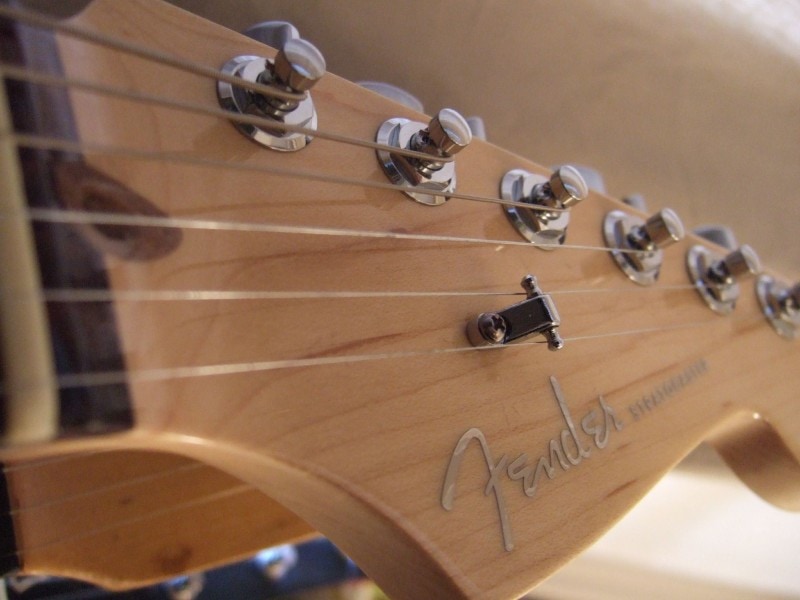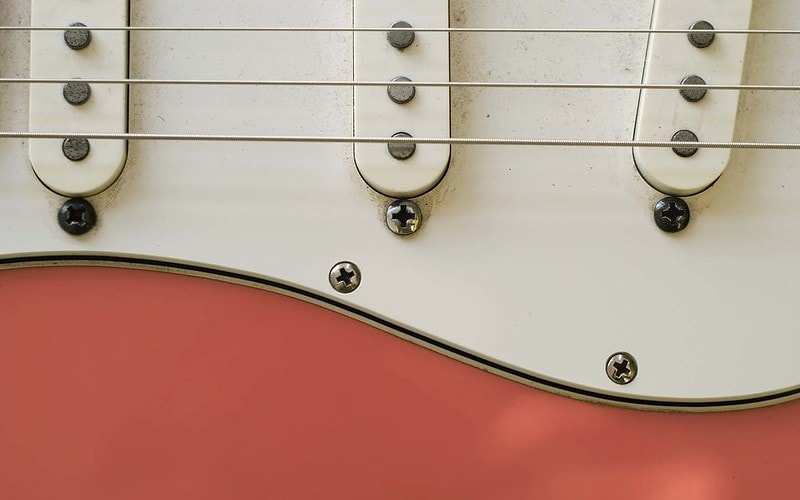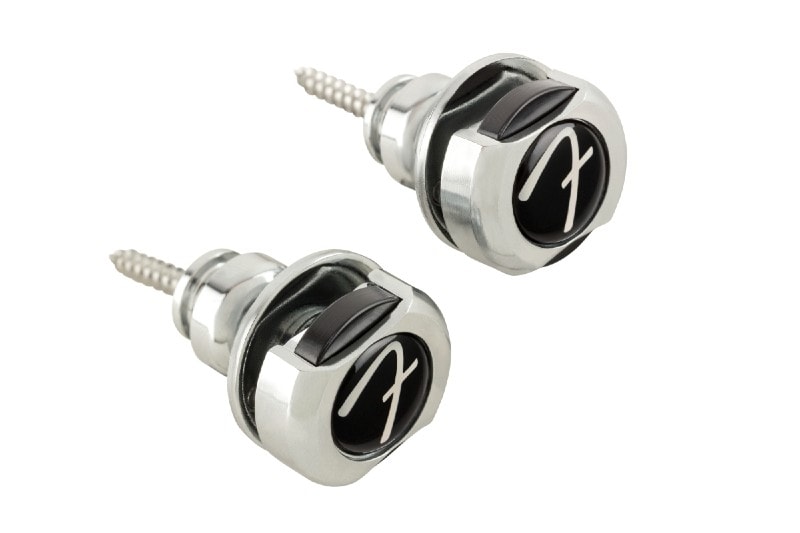If you’re thinking of upgrading your Strat, be it a Fender or Squier, make sure you have a plan.
Upgrading for the sake of upgrading is throwing away money. Why swap the bridge pickup for a humbucker if you always play in the 4th position? Is it worth adding a treble bleed if you always play full-tilt? Does it make sense to swap out the strap locks if the guitar doesn’t stay in tune in the first place?
This article isn’t designed to be a checklist. Rather, it’s designed to help you fix whatever the problem is with YOUR Strat.
- If your Strat doesn’t stay in tune, look at the nut and tuners.
- If your Strat doesn’t have much sustain or chime, look at the bridge.
- If you want your Strat to shred, look at the pickups.
- If you want your Strat to be more versatile, look at the electronics.
- If you move around a lot on stage, get strap locks.
If you’re careful to put your money in the right place, you’re sure to create a beast of a Strat that’s all your own.
Contents
- Strat Mods – Strat Tuner Replacement
- Strat Mods – Replacing a Strat Nut and String Tree
- Strat Mods – Stratocaster Replacement Pickups
- Strat Mods – Strat Replacement Bridge
- Strat Mods – Replacing and Upgrading Electronics on a Strat
- Strat Mods – Hardware (strap locks and jack replacement)
- Final Thoughts on Stratocaster Upgrades
Strat Mods – Strat Tuner Replacement
Upgrading your existing tuners to a good set of locking tuners, or even just a well-made set of vintage-style tuners, is one of the first Stratocaster upgrades many people make. It can have a huge effect on the tuning stability of your guitar, as well as the ease and speed with which you tune up.
However, picking a new set of tuners can be a bit of a minefield, as there are so many options out there. Some people want locking tuners to make string changes easier, others want more traditional-looking tuning keys or even black tuning keys to make their Strat appear a little hot-rodded.
Another issue is the differing mounting holes for tuners. Fender’s vintage-style tuners fit an 11/32″ (8.7mm) tuning hole and have a .249″ diameter string post, while the die-cast tuning machines fit a 13/32 (10mm) hole with a .236″ diameter string post. This means you will need to widen the holes to switch from vintage to modern (a task for a luthier), whereas going from modern to vintage will require conversion bushings (StewMac makes them in a variety of sizes and finishes), unless you want to try to fill out the wood, which is a big task.
If you decide to go with locking tuners for your tuner Strat mod, the Hipshot Grip-Lock 6 inline 21mm Locking Tuners are a solid choice. Hipshot makes some of the best aftermarket locking tuners for 6-in-line setups like you find on a Stratocaster. Because they come with a universal mounting plate, they should fit most Squier models with minimal drilling. Not only do they offer locks for fast string changes and good tuning stability, they also offer a staggered post option, which sets up the guitar with the perfect break angle over the nut, making any Strat feel much more like a US-made Fender.
Should you decide to go the non-locking route, there are other excellent options on the market that offer great looks and solid tuning stability. If you want the vintage look, Fender’s Road Worn Vintage-Style tuners offer rock-solid stability and look incredible.
If you are upgrading tuning keys on a Squier, you also need to be aware that you can’t just drop Fender tuning keys into a Squier Strat, due to the pins (which sit into the back of your headstock from the tuners) being different sizes. So while they are often the gold standard, you’ll want to look elsewhere for drop-ins. If your aesthetic is more modern, these Wilkinson E-Z Post tuners also look great and offer a plug-and-play tuner upgrade for most Squier models.
Strat Mods – Replacing a Strat Nut and String Tree

The biggest advantage of a nut replacement – typically the second most popular strat upgrade – is an increase in tuning stability and improved tone when playing open strings. Luckily with a Strat you’re not looking at the kind of issues Gibson owners have with their G strings, but a cheap or badly-cut nut can leave you scratching your head as you tune-up every few minutes.
As with most production guitars these days, a Strat’s nut out of the factory can be something of a weak point. Squiers and Mexican Strats in particular suffer from either cheap plastic nuts or, in the case of the newer Player Series guitars, a melamine nut that’s better used as dishware than something you’d want your strings sitting in.
Typically people look to either bone nuts or Tusq nuts for replacements. You can read our opinion on the Tusq-vs-bone debate here, but the takeaway is that if you drop a bone nut, it makes a thud. If you drop a Tusq nut, it rings. Tusq XL nuts in particular are impregnated with PTFE (the chemical name for Teflon). This makes Tusq XL nuts self-lubricating, which goes a long way towards extending the life of your string, and ensuring the guitar stays in tune for longer.
One thing to be aware of when selecting a nut for your guitar is whether it fits into a flat or curved slot. There’s no hard-and-fast rule here unfortunately, so you’ll need to either remove your nut during a string change to check (which can be tricky if it’s glued in) or Google your model to find out.
On the upside, Graph Tech does make a Tusq nut with a notch that allows the nut to sit flat. If you need it to be curved, you just pop out the notch.
Exercise caution when removing your old nut. Particularly in the Indonesian-made Squiers, the original nut is installed with a healthy dose of superglue. In many cases, the only way to remove it without risking damage to the fretboard or headstock is actually to cut it out with a fine hacksaw blade. To avoid similar issues should you ever decide to change it again, a small dab or two of superglue should be more than sufficient to keep the new nut in place.
String trees are an underrated upgrade for any Stratocaster. Because Strats have a flat headstock, they require a means of putting downward pressure on the strings, particularly the high strings, in order to prevent them from rattling, buzzing, and creating a “sitar” effect within the nut when strings are played open. They are absolutely essential on all Fender and Squier guitars due to the nature of their design.
The stock string tree on Mexican Fender and Squier Stratocasters is made from cheaper stamped metal and as a result of its manufacturing process, is often left with sharp edges and burrs. As you play, particularly when bending strings, this can damage the strings, causing premature breakage. Upgrading to better-quality string trees (also called string guides) made with better materials and superior finishing quality will help extend the life of your strings. If you want to keep the stock look and just upgrade the component, these Fender Vintage-Style string trees are an excellent choice. For even better performance, consider moving up to these Musiclily Roller String Trees. Their rolling action significantly reduces string friction and the ‘grabbiness’ that can sometimes happen with stamped components when using the tremolo arm.
Strat Mods – Stratocaster Replacement Pickups

Changing your pickups provides an immediately noticeable effect on the overall sound of your guitar. Stock pickups in Squier Strats are notoriously muddy, so, even if you don’t change anything else, an upgraded set of pups can really breathe new life into your axe (far beyond simply adjusting the height).
There are literally hundreds of options available when it comes to pup upgrades, so if this is your first time diving into this particular Strat upgrade, it can be tough to know which direction to go. If there’s an artist with a particular sound you’re looking for, research which pickups they use. Even if you don’t go with that particular model, you can look for other pickups with similar sound-profiles.
The classic Stratocaster setup is three single pickups, although the HSS (humbucker at the bridge, singles in the middle and neck positions) setup is quickly gaining popularity. If you wanted to take things a step further and install a second humbucker at the neck, there is a good chance your Strat is already able to do this. Hidden under the pickguard of some Squier and MIM models is a rout large enough to accommodate a neck humbucker.
If your Strat isn’t routed for traditional humbuckers, you still have options. For example, the Seymour Duncan SHR-1 Hot Rails neck and bridge pickups can be installed in a single-coil size slot. They are some of the hottest pickups in Seymour Duncan’s lineup, offering the classic, fat humbucker sound prized by bluesmen, hard rockers, and jazz musicians alike. They don’t come in a set, but this also gives you the flexibility to install just the bridge, or the bridge and the neck, while still keeping the middle single coil.
Those looking to retain the traditional Strat three single-coil pickups without breaking the bank should consider the Tex Mex set from Fender. You should notice an immediate reduction in 60 cycle hum vs. your stock pups after installation. Fender’s Tex Mex work well playing the clean tones of the ’50s and ’60s, right through to the high-gain, overdriven rock and funk of the Hendrix era.
Not only can you change the three pups individually, you can even buy loaded pickguards. These contain a complete electronics upgrade (except for the input jack), pre-installed in a new pickguard, often without any soldering required, making them an almost plug-and-play solution. Some of the options for loaded pickguards include the 57/62 set from Fender, the DG20 David Gilmour set or the KH20 Kirk Hammet set from EMG, or the Lace Sensor Rainbow Pack.
If you are considering the loaded-pickguard route, make sure you count your pickguard screws and measure the distance between them. Even between Squier and Fender MIM models, there are differences in the screw arrangement that can require additional drilling to install.
Strat Mods – Strat Replacement Bridge
A bridge upgrade on a Strat is not likely to yield huge tone improvement like it would on an acoustic guitar. What it will do is improve playability, tuning stability, sustain, and overall performance, making it a worthwhile Stratocaster upgrade.
If your Strat has a tremolo bridge, you have a couple of options available as far as upgrades go. First, you could perform a like-for-like upgrade. If you’re a Squier player, you could consider the Fender Mexican Standard tremolo bridge. It offers superior quality materials, as well as a nicer fit and finish to the stock examples that come on Chinese and Indonesian-made Squiers. It’s also a very affordable upgrade.
Those looking for extra sustain without having to go to the trouble of replacing the entire bridge should consider replacing their trem block. From the factory, most Squier Strats come with a lightweight zinc-alloy block. The OEM component is not ideal for sustain, and can literally disintegrate over time.
Fortunately they can be easily replaced with a brass or steel block, which provides some improvement in that area for a very small investment. On the downside, this option is really only available if you are working with a full-size Stratocaster body, such as those found on the Classic Vibe series, the Squier Stratocaster Standard, or the MIM Fender Strats. If you have one of these instruments, this brass block from Musiclily is a solid option.
Slim-bodied versions such as the Bullet and Affinity Series don’t have sufficient depth to accommodate available aftermarket upgrades to the block alone, leaving owners of these guitars with only one option – replacing the entire bridge.
Should you be looking for serious upgrades, you could install a Floyd Rose trem bridge. Retrofitting a traditional Floyd Rose would require drilling, whereas their Rail Tail Tremolo model is a drop-in replacement for any Stratocaster with an existing 6-point trem. It offers around 15 extra degrees of articulation than the standard Fender or Squier bridges, so you’ll be able to get the crazy dive bombs that Floyd Rose bridges are famous for. And thanks to the roller saddles, tuning stability is still strong and string changes aren’t the nightmare you’ve heard about.
For hardtail players, replacement bridges are an even more straightforward Strat modification. As with trem bridge upgrades, you should be looking for good fit and finish. Stock bridges can sometimes have somewhat of a rough finish, with burrs and sharp edges. Upgraded bridges should also provide smoother saddle adjustment, making action and intonation adjustments easier and more accurate (for more on these terms, check out our guide to action and our guide to intonation).
If you’re approaching your upgrades looking for the best of the best components, this Gotoh Hardtail Bridge is superbly finished, includes all hardware, and is equipped with brass saddles. If your budget is tighter, but you are still looking to improve on your stock bridge, this Wilkinson Hardtail Bridge offers excellent value for money. Again, all hardware is included and the saddles have a lovely satin finish.
Strat Mods – Replacing and Upgrading Electronics on a Strat
Upgrading the electronics in your Stratocaster is a great way to improve reliability, sound, and playability. Over time, through vibrations and general wear and tear, electronic components can fail. Unfortunately, the electronics in a Strat are hidden, so when they break down, it could potentially be in the middle of a performance with no prior warning.
The electronics may be hidden from sight, but they aren’t particularly difficult to access. You will need to unscrew your pickguard, but be super careful doing so, as your electronics are directly connected to it in most cases. For the easiest access, remove your strings.
When you have the guitar broken down, you’ll see that the internal electronic components consist of potentiometers (or pots), capacitors, switchgear, and wiring.
Potentiometers
Potentiometers are your volume and tone controls. Upgrading them can actually have a significant effect on the sound and playability of your Strat. If you are upgrading a Squier Stratocaster, you will find that your stock pots are “dime-sized”. These small controls are fairly standard on import guitars, and are often binary in nature – on or off. This makes it almost impossible to achieve a nice swell of tone or volume as they have a sharp drop-off when adjusting.
Upgrading to a quality full-sized, or quarter-sized set from the likes of Bourne or CTS is a no-brainer Strat upgrade that will drastically increase the potential of your guitar and unlock sound profiles you didn’t even know it was capable of. If you are playing a MIM Strat from 2006 or newer, you probably won’t need to upgrade your pots, since full-size CTS gear is OEM standard on those models.
When shopping for potentiometer upgrades, you will find that you have a choice between 250k or 500k. Both will work in any Stratocaster, but to achieve the best possible sound, you should make your selection based upon your pickups.
The potentiometers work to dampen high frequencies coming from the pups by creating a short across the signal. The lower the value on the pot, the lower the resistance. This allows more of the high frequencies to bleed off to ground. So, if you choose to stick with single-coil pickups, your guitar will sound best with CTS 250k pots, which tame the high-frequency output.
If you’ve decided to install humbuckers, like the SD Hot Rails, it’s advised to change to CTS 500K pots, since their increased resistance will prevent the bleed-off of high frequencies, allowing more highs through, thus preventing them from sounding too muddy. As 500k pots aren’t very common on Strats, you will likely have to purchase 3 single potentiometers.
Capacitors
While they form an essential part of the potentiometer, tone capacitors are able to be independently changed and upgraded using differently specced components. Tone caps perform the task of further impeding frequencies to alter the tonal properties of the guitar, and their resistance is measured in Microfarads.
As a guitarist opens their pots up, they send more of the signal through the tone cap. The larger the tone cap, the more high frequencies are suppressed, resulting in an overall softer, warmer tone. If this is the sound profile you’re after, 047uF caps are recommended. If you want to retain the traditional, bright Strat tone, consider a set of lower-value 0022uF caps.
Unless you plan to change the resistance of your capacitors, this upgrade should be seen as a way to increase reliability and longevity. A brand-name capacitor won’t provide any tone difference vs. stock, but quality capacitors have a longer lifespan. Orange Drop are renowned for quality electronic components and are worthy of your consideration.
Switchgear
The stock switchgear on Squier and MIM Stratocasters is notorious for extra “play”. Over time, this play can turn into wobble, which will eventually result in crackling and popping when switching between pickups. These unwanted noises will almost certainly cut right through the mix during live performances, which most players want to avoid at all costs. This means it’s unlikely to be the first out-of-the-box upgrade you do on a Strat, but one that makes sense down the road.
If you do upgrade to a quality selector switch, such as this one from Oak Grigsby, you will notice a significantly more positive engagement in each selector notch, which will result in fewer accidental changes to pickup selection, and elimination of unwanted noise.
Standard Stratocaster selector switches have 5 positions:
- Neck
- Neck/Middle
- Middle
- Middle/Bridge
- Bridge
For greater versatility, selector switches can also be swapped out for ones with different pickup selection mapping. For example, you could install an Oak Grigsby 6-way switch, that includes all of the above settings. It also has an additional one that could be used to activate all 3 pups, or even activate the neck and bridge together, and get the Telecaster sound from your Strat.
Shielding
The stock single-coil pickups on Mexican Sand Squier Strats are often very hot, and this results in excessive 60 cycle hum. To reduce this, you can create a Faraday cage within your guitar by shielding it. This involves removing all of the electronics and coating the entire cavity with a layer of self-adhesive copper tape. You should do the same on the underside of the pickguard.
Strat Mods – Hardware (strap locks and jack replacement)

Any gigging musician should give real consideration to upgrading their Stratocaster’s hardware, specifically the strap nuts and the output jack. Both components are particularly prone to failure, and these failures are significantly accelerated by enthusiastic on stage movement.
Dropping your guitar on stage could be potentially disastrous and would likely cause serious damage. Most accidental guitar drops are caused by loose strap nuts, or simply because the strap slipped off while the player was moving. Fortunately, this is easily fixed with a simple set of strap locks. There are a wide variety on the market, including genuine Fender components or from quality brands like Ernie Ball. Not only do they feature their respective locking mechanisms, but they come with slightly longer and wider mounting screws, which increases their security.
Output jacks tend to take a lot of punishment. When the cable is stretched to its limit, it will start tugging at the jack, which will in turn loosen the connectors on the output jack socket. Much like the selector switch and pots, when output-jack connectors begin to become loose, they will produce crackles and pops whenever the guitar is moved.
By installing an upgraded output jack, such as this one from Puretone, you will gain increased strength and therefore increased resistance to failure of the connectors.
If you are only looking to change the aesthetic of your guitar, you can opt to just change the jack-plate cover. They are available in almost all colors and can add a unique touch of customization that makes your Strat stand out.
Final Thoughts on Stratocaster Upgrades
The Stratocaster has been one of the world’s most-popular guitar models for decades and for good reason. These truly are awesome and versatile guitars that transcend genre. Their modular nature means you can take even the cheapest Squier and, with a few tactical upgrades, have a heck of a machine that will give you hours of joy, and sound much more expensive than its price tag suggests.
However, upgrading for the sake of upgrading can be a waste of time. Too many of us try to cure a little GAS by buying extra accessories for our guitar. If that’s you, just swap out the strings, spend the time learning a new song, or spend the money on a few guitar books!
At the end of the day, it is all about what sounds good to you. So, if you feel your Strat is lacking in certain areas, there are literally thousands of combinations of mods and upgrades to improve it, at prices to suit every budget.


